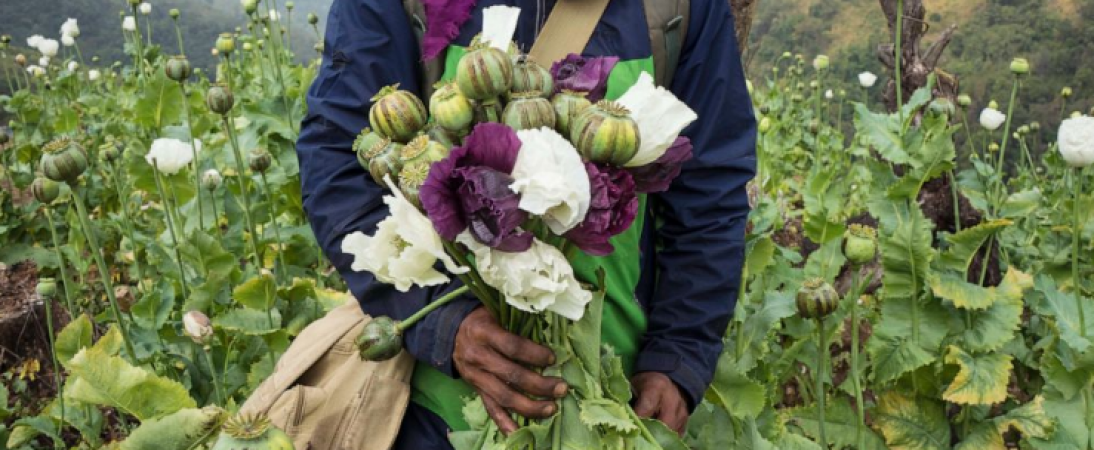
BANGKOK: Opium cultivation has increased by a third in the past year as eradication efforts slow and a faltering economy encourages more people to join the drug trade.
According to the United Nations report released on Thursday. Opium production in Myanmar has increased significantly since the military took control of the country.
According to the United Nations Office on Drugs and Crime report, Myanmar will see a 33% increase in its cultivated area to 40,100 hectares (99,090 acres) in 2022, since the military seized power from the democratically elected government of Aung San Suu Kyi. The first was a full growing season. Qi in 2021.
Also Read: Afghan refugee sentenced to life in prison in the UK for murder
"Economic, security and governance disruptions come together after the February 2021 military takeover," said Jeremy Douglas, the regional representative of the United Nations Office of the People's Liberation Army.
"Farmers in remote, often conflict-prone areas in the northern Shan and border states had little choice but to turn back to opium."
According to United Nations estimates, the total value of the opium industry in Myanmar ranges from $660 million to $2 billion, depending on how much was sold locally and how much raw opium was converted into heroin or other drugs. Was.
According to Douglas, Myanmar remains the world's second largest opium and heroin producer after Afghanistan. "Almost all the heroin reported in East and Southeast Asia and Australia originates in Myanmar," he said.
“At this point, there is no comparison between the two as Afghanistan is still producing more, but the expansion in Myanmar should not be ignored and needs attention as it is directly related to the security and economic situation. is related to what we are currently seeing."
In the past, opium was widely produced in the so-called Golden Triangle, where the borders of Myanmar, Laos and Thailand meet. There were also several laboratories in the area that turned opium into heroin.
Myanmar's frontier regions, also known as Burma, have been largely lawless due to decades of political instability, making them attractive to drug growers and smugglers.
Also Read: New Zealander who died in Ukraine assisted numerous, according to parents
According to Douglas, most of Myanmar's opium exports go to China and Vietnam, while heroin is shipped to several countries in the region.
For smugglers, "this is really where the value is," he declared. Really high profits. The military took over the government in 2021, but poppy cultivation had declined in recent years.
In 2020 the production estimate dropped to 400 metric tons (440 tonnes). According to the report, there is a slight increase in 2021 before rising to an estimated 790 metric tons (870 tonnes) in 2022.
The military's use of lethal force to maintain power since seizing control of the government has escalated the conflict with its civilian opponents to such an extent that some experts say the nation is currently in a state of civil war. .
The cost has been high, with 2,810 people killed by government forces and 17,427 arrested so far, according to the Assistance Association for Political Prisoners.
The government had to divert its resources due to the violence, which prevented it from conducting drug-eradication raids in some areas. As a result, eradication efforts have decreased significantly as 1,403 hectares (3,467 acres) were eradicated in 2022, about 70% less than in 2021.
The UN reported that an increasing number of rural households have been forced to rely more heavily on poppy cultivation for income as the conflict is having a negative impact on Myanmar's economy.
According to Douglas, the root cause of the current increase in opium production is poverty and how rural residents are responding to the economy.
It has always supported me in difficult times. Those involved in the drug economy are largely unregulated, and the security situation is understandably difficult due to the frequency and intensity of conflict.
Also Read: On ISS a UAE astronaut claims that fasting during Ramadan is not necessary
The same factors have led to a boom in its synthetic drug industry, with seizures of methamphetamine and other narcotics reaching record highs in the region.
For example, during a single raid in September in Laos, authorities seized 500 kg (1,100 lb) of crystal methamphetamine and 33 million methamphetamine tablets.